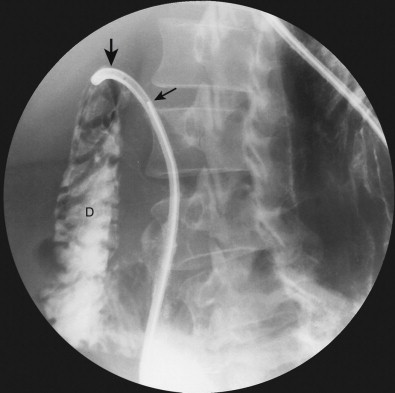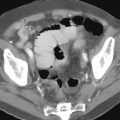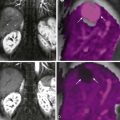Chapter Outline
Principles for Performing and Interpreting Small Bowel Examinations
Small Bowel Studies Using Water-Soluble Contrast Agents
Retrograde Examinations of the Small Intestine
Choice of Fluoroscopic Examination
The focus of this chapter is on barium examinations of the mesenteric small intestine. Normal anatomy pertinent to understanding barium examinations is presented. The variety of contrast examinations for studying the small intestine is then described. Finally, a symptom-based approach to contrast imaging of the small intestine is presented.
Normal Small Intestine
The small intestine is extremely tortuous, beginning at the pylorus and extending about 11 feet in the living human from the pylorus to the ileocecal valve. Intestinal length is extremely variable, depending on neuromuscular tone and vascular flow. For example, the denervated, bloodless intestine stretched at autopsy varies from 10 to 30 feet. A patient with a small bowel obstruction will have a tortuous, long, and wide small intestine in which the jejunum may fall deep into the pelvis.
The mesenteric portion of the small intestine is suspended from the retroperitoneum by the relatively short root of the small bowel mesentery, extending about 15 cm from the duodenojejunal junction to the right iliac fossa. The mesenteric small intestine is divided into the jejunum and ileum. The jejunum arbitrarily comprises the proximal 40% of the mesenteric small intestine and the ileum makes up the distal 60% ( Fig. 37-1 ). The jejunum typically occupies the left upper quadrant, and the ileum occupies the pelvis and right lower quadrant. The location of the jejunum and ileum is often variable, however, given the mobility of the intestine on the root of the mesentery. Not infrequently, the jejunum flops into the right upper quadrant or changes position during fluoroscopic examination of the small bowel.

The small intestine has a smooth curvilinear contour, as readily seen on abdominal radiographs or cross-sectional imaging studies in patients with free intraperitoneal air. The inner contour of the intestine is characterized by folds that encircle the lumen, known as the folds of Kerckring, valvulae conniventes, or plicae circulares ( Fig. 37-2 ). These folds are composed of mucosa and submucosa ( Fig. 37-3 ) and increase the surface area of the small intestine by 300%. The small bowel folds lie perpendicular to the longitudinal axis of the intestine and are thicker, taller, and more numerous in the jejunum than in the ileum ( Table 37-1 ). Villi are leaf- or finger-shaped protrusions of epithelium and lamina propria (see Fig. 37-3 ) that stud the surface of the folds. Each villus has a core of lamina propria containing a cellular stroma, capillaries, a lacteal, and nerves. Villi are tall and thin in the jejunum and shorter and broader in the ileum. Duodenal villi are more variable and can be short and broad, leaf-shaped, or branched. The villi are about 1 mm in cross section and are just at the limits of fluoroscopic resolution ( Fig. 37-4 ). In contrast, the microvillous brush border of the small intestine is invisible on all radiographic examinations.
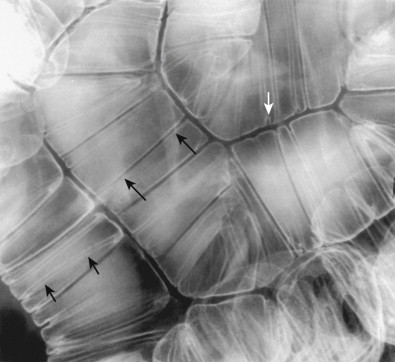
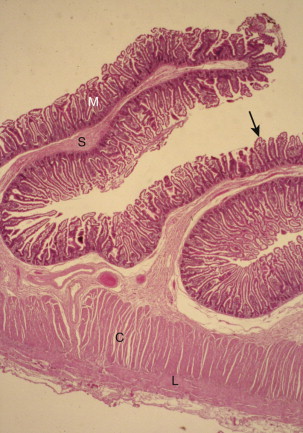
| Parameter | Enteroclysis | Small Bowel Follow-Through |
|---|---|---|
| NUMBER OF FOLDS PER INCH | ||
| Jejunum | Four to seven | Difficult to count |
| Ileum | Two to four (or less) | Difficult to count |
| FOLD THICKNESS (mm) | ||
| Jejunum | 1-2 | 2-3 |
| Ileum | 1-1.5 | 1-2 |
| FOLD HEIGHT (mm) | ||
| Jejunum | 3-7 | Difficult to assess |
| Ileum | 1-3 | Difficult to assess |
| LUMEN WIDTH (cm) | ||
| Jejunum | <4 cm | <3 |
| Ileum | <3 | <2 |
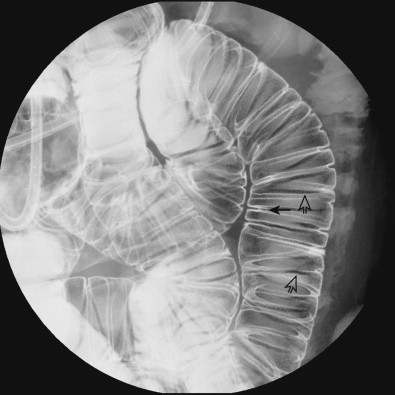
The small intestine is one of the largest immunologic organs of the body and a major site of interaction with foreign food antigens, pathogens, and toxins. The host defenses begin at the epithelial surface with a mucus layer containing immunoglobulins (especially secretory IgA) and enzymes. This mucus prevents microbes from adhering to the epithelium and acts as a buffer and lubricant. A variety of other defenses also protect the host from these food antigens, including intraluminal gastric acid, bile salts, and pancreatic enzymes, and small bowel peristalsis.
The small bowel epithelium is composed of a single layer of cells bound by tight junctions impermeable to large molecules and pathogens. Intramucosal phagocytes include granulocytes, macrophages, and Paneth cells. Three distinct lymphocyte populations are present in the intestine within the epithelium, lamina propria, and Peyer’s patches. Intraepithelial lymphocytes are located in the basal portion of the epithelium and comprise up to 30% of the cell population in the mucosa . Immunocytes in the lamina propria are composed mainly of IgA-secreting plasma cells and lymphocytes. T lymphocytes of helper-inducer and suppressor-cytotoxic types are present. Lymphoid aggregates span the muscularis mucosae, with portions of these aggregates in the lamina propria and submucosa. These lymphoid aggregates increase in size and number in the distal ileum ( Fig. 37-5 ), forming confluent Peyer’s patches in the lower ileum. A specialized epithelium that is one cell layer in thickness separates these lymphoid aggregates from the lumen, facilitating antigen processing. The lymphoid aggregates do not have a capsule, defined borders, a medulla, or afferent lymphatics that are present in lymph nodes. The follicular areas are composed of B cells, and the parafollicular regions are composed of T cells.
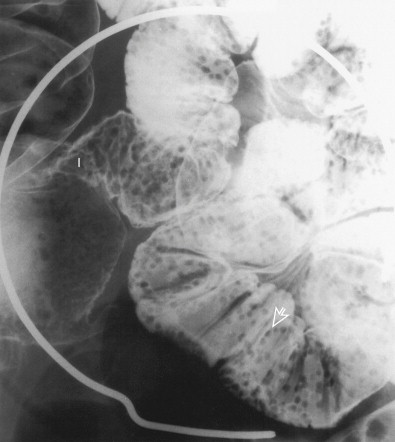
Principles for Performing and Interpreting Small Bowel Examinations
The small intestine is a difficult structure to image. The intraluminal environment is hostile to barium preparations. A large amount of fluid (≈9 L) enters the small intestine each day, with only 1.5 to 1.9 L entering the colon. Bile acids, gastric acids, pancreatic secretions, and the epithelial mucus layer interact with barium in the small intestine. Fortunately, most modern barium suspensions no longer suffer from flocculation and clumping, as often occurred in the past.
Because of the inherent length and motility of the small intestine, imaging of this structure can take a long time. Intestinal loops overlap and change in size, shape, and position with peristalsis. Normal small bowel transit ranges from 30 to 120 minutes. The transit time can be lengthened dramatically in patients with obstruction or adynamic ileus from various causes.
The radiologist evaluates the overall location, course, and size of various portions of the small intestine. For example, the radiologist determines the location of the duodenojejunal junction and the location of the first loops of jejunum. The radiologist also evaluates the luminal contour and searches for abnormalities that extend beyond the small intestine (e.g., diverticula [ Fig. 37-6 ], sacculations, ulcers, exoenteric masses) or lesions that protrude into the lumen (e.g., polyps [ Fig. 37-7 ], abnormal folds). The small bowel folds are best evaluated when the lumen is fully distended, and the folds lie perpendicular to the longitudinal axis of the bowel. Fold width also depends on the degree of luminal distention; the greater the distention, the thinner the folds appear ( Fig. 37-8 ). The folds are best shown after mucus has been washed off the luminal surface by the barium column. If folds are evaluated long after the barium column has passed, intestinal secretions can lift barium away from the mucosal surface so that the folds may erroneously appear thickened. En face mucosal detail is seen during compression of the barium column or with double-contrast technique. Visualization of this mucosal detail is necessary for detecting mucosal granularity or nodularity or small ulcers, such as aphthoid ulcers ( Fig. 37-9 ).
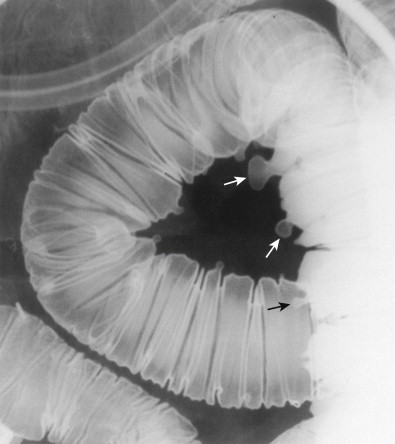
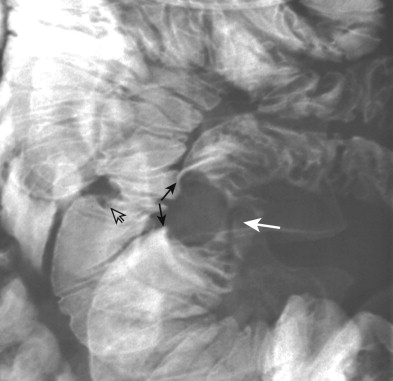
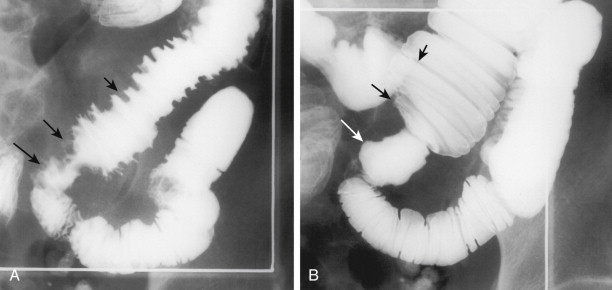
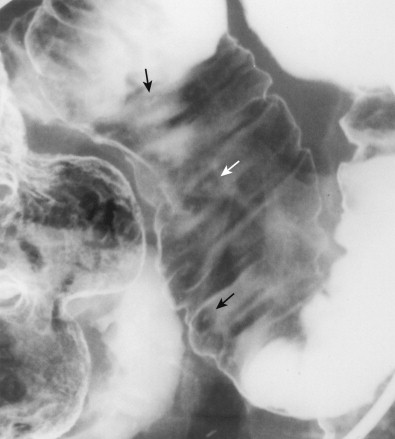
Fluoroscopy is a key component of any small bowel examination. The radiologist examines the head of the barium column to understand the course of the small intestine and to detect contour abnormalities or filling defects in the barium column. The radiologist also assesses bowel motility, distensibility, and pliability during the fluoroscopic examination. Fixation of intestinal loops can also be recognized by manual palpation of the bowel.
Small Bowel Follow-Through
There are many ways to perform a small bowel follow-through examination. In this chapter, I discuss the technique that I use. A small bowel follow-through is a single-contrast examination of the esophagus, stomach, and small intestine that uses barium most appropriate for the small bowel. For this examination, the patient drinks a large volume (500-1000 mL) of low-density (30%-50% w/v) barium specifically designed for evaluating the small intestine.
The patient should not eat or drink after 9 to 11 pm the day before the examination. If a peroral pneumocolon is to be performed, the patient should receive a barium enema preparation to cleanse the terminal ileum and right side of the colon.
A single-contrast upper gastrointestinal (GI) series is often performed (using 1-2 cups of low-density barium) as a prelude to examining the small bowel. The purpose of the upper GI series is to show gross upper GI involvement by diseases that affect the small bowel, such as Crohn’s disease and scleroderma. Esophageal or gastric abnormalities may also be detected as incidental findings, given the high frequency of upper GI disorders such as gastroesophageal reflux disease. However, a double-contrast upper GI examination using high-density barium is not performed, because this barium is not designed for evaluating the small intestine and, if used, high-density barium often prevents adequate visualization of pelvic small bowel loops. The radiologist therefore sacrifices double-contrast evaluation of the upper GI tract to ensure a more optimal examination of the small intestine. After the esophagus, stomach, and duodenum are evaluated, the patient leaves the fluoroscopic suite and slowly sips an additional 1 to 2 cups of low-density barium.
In some practices, a technologist obtains overhead radiographs and a radiologist evaluates the overheads views, only fluoroscoping and palpating the small bowel when an abnormality is suspected or when barium has reached the terminal ileum. Such an approach is strongly discouraged. A small bowel follow-through relies on fluoroscopic detection and spot image documentation of all abnormalities. Each loop of small bowel is palpated when it is optimally distended by low-density barium ( Fig. 37-10 ). The radiologist should therefore evaluate the patient at least several times—about 15 to 30 minutes after the single contrast upper GI series is performed and then at 15- to 45-minute intervals, depending on how fast the barium column is progressing through the small intestine. The patient is turned into various positions, and manual palpation (including supine, lateral, and prone compression views) is used to splay out individual small bowel loops. In my practice, I no longer obtain overhead radiographs. If the big picture is required, a digital spot radiograph obtained at the lowest magnification is usually adequate for this purpose.
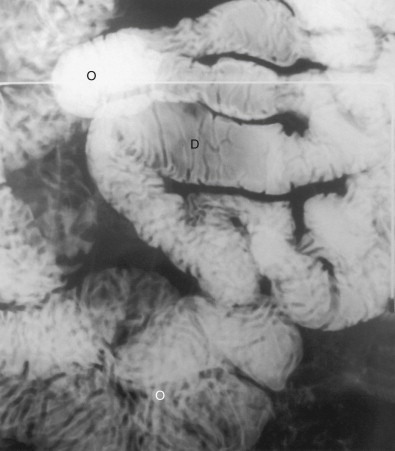
The length of the examination can be shortened by administering a standard dose of 20 mg of metoclopramide (Reglan) orally 20 to 30 minutes before the study or 10 mg intravenously at the beginning of the examination. Metoclopramide accelerates gastric emptying and small bowel transit. Unfortunately, metoclopramide also increases resting muscle tone, resulting in incomplete small bowel distention. The result is a faster but less optimal examination.
Some radiologists administer two to three doses of effervescent agent (600-900 mL of CO 2 ) when the barium column reaches pelvic loops of ileum or the terminal ileum. This technique shortens the examination and demonstrates small bowel loops on an air-contrast study. Nevertheless, administration of an effervescent agent can be uncomfortable because large volumes of gas can incite intestinal cramping. It also results in decreased luminal distention in comparison to enteroclysis, and only one third to one half of the small bowel is shown on the air-contrast study.
Some radiologists use a premade mixture of 24% w/v barium suspended in methylcellulose. This barium suspension produces greater luminal distention than a routine small bowel follow-through, as well as a transradiant effect that mimics enteroclysis. However, the barium is not as dense as that used for a routine small bowel follow-through so it can be more difficult to detect filling defects in the barium column. Luminal distention is also less than that in enteroclysis, because it is limited by the rate of gastric emptying at the pylorus.
The small bowel follow-through has two important limitations. Even with the use of metoclopramide, the pylorus delays emptying of barium from the stomach so the small bowel may be incompletely distended. As a result, it can be difficult to evaluate luminal contour ( Fig. 37-11 ) or detect filling defects in the barium column. Because normal transit time for the small bowel is 30 to 120 minutes, it also is not feasible for the radiologist to remain in the fluoroscopy suite for the entire examination. As a result, the small bowel can only be evaluated intermittently, and lesions can be missed, depending on the degree of filling and distention of individual small bowel loops at the time of fluoroscopy.
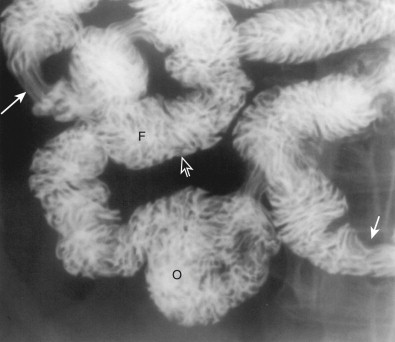
Peroral Pneumocolon
A peroral pneumocolon may be performed in conjunction with a small bowel follow- through. This is a double-contrast examination, primarily used to evaluate patients with suspected Crohn’s disease in the terminal ileum or evaluate the right side of the colon in patients in whom a barium enema or colonoscopy failed to visualize this portion of the bowel adequately.
The patient undergoes a barium enema preparation to clear feces from the terminal ileum and right side of the colon. After a routine small bowel follow-through has been performed, 1 mg of glucagon is administered intravenously, and air is insufflated into the rectum via a Foley catheter. The colon is slowly distended with air as the patient is turned into various positions to manipulate air into the cecum and terminal ileum. Air can be refluxed successfully into the terminal ileum in 85% to 90% of patients. Double-contrast spot images of the pelvic ileum, terminal ileum, and right side of the colon are then obtained ( Fig. 37-12 ).
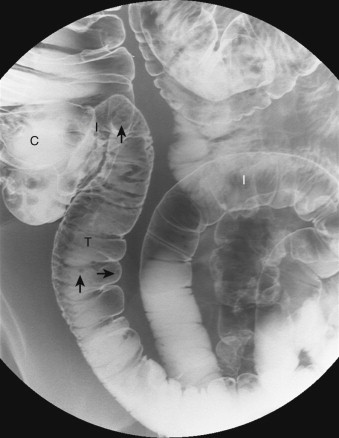
Enteroclysis
The small intestine has been examined via intubation techniques since the 1920s. All these techniques entail positioning a tube beyond the pylorus, overdistending the small bowel with various contrast agents, and detecting abnormalities at fluoroscopy. The multiplicity of techniques for performing enteroclysis reflects the imperfections of each individual technique. Lack of universal acceptance of this procedure by the radiologic community is related to the relatively high level of expertise needed to perform enteroclysis and to patient discomfort during the intubation procedure.
Preparation
An unprepped patient often has feces in the terminal ileum and right side of the colon. This fecal matter obscures mucosal detail, mimics polyps, and impedes passage of contrast material through the distal ileum. A preparation is therefore given to clear feces from the terminal ileum and right colon before the examination. This can be a full barium enema–type preparation, including osmotic cathartics such as magnesium citrate and colonic stimulants such as bisacodyl. At my institution, I have achieved successful cleansing of the right side of the colon with a clear liquid diet the day before the examination combined with four 5-mg tablets of bisacodyl given the evening before the examination. The patient does not eat or drink after midnight. On the day of the examination, the patient should temporarily discontinue medications such as narcotics that decrease small bowel peristalsis.
Metoclopramide
Metoclopramide is administered orally or intravenously before the examination. Metoclopramide begins to take effect 1 to 3 minutes after intravenous (IV) injection of a 10-mg dose or 30 to 60 minutes after ingestion of two 10-mg tablets. This drug facilitates passage of the enteroclysis catheter by relaxing the pyloric sphincter and duodenal bulb and by increasing gastric antral contractions. Passage of barium through the small bowel is accelerated because metoclopramide increases peristalsis in the duodenum and jejunum. Metoclopramide may also improve visualization of strictures in Crohn’s disease ( Fig. 37-13 ). However, its use is contraindicated in patients with known pheochromocytomas because it may stimulate catecholamine release from these lesions, precipitating a hypertensive crisis. It is also contraindicated in patients with epilepsy or patients receiving drugs that may cause extrapyramidal reactions because it increases the frequency and severity of seizures associated with these reactions.
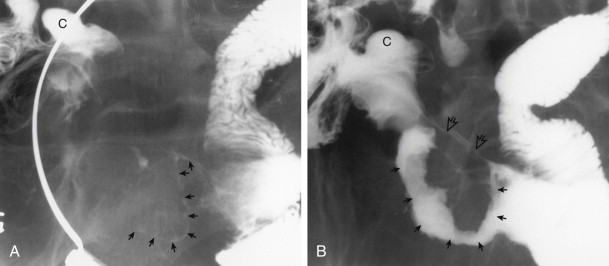
Anesthesia
The major complaint that patients have about enteroclysis is intubation. Patients can be made more comfortable by the use of conscious sedation. One protocol for conscious sedation includes a combination of fentanyl or diazepam for analgesia and midazolam for an amnesic effect. Oral diazepam alone can be used as an alternative.
Intubation
A variety of enteroclysis catheters are available from several manufacturers. The catheters have a diameter of 8 to 13 F, an end hole or side holes, and a balloon attached to their tips. One manufacturer has a multiple-lumen catheter capable of a diagnostic study and therapeutic decompression.
I suggest having the patient ingest a small amount (15-30 mL) of enteroclysis barium orally before intubation. This barium coats the antrum, pylorus, and duodenal bulb, which are important landmarks that guide the radiologist in passing the enteroclysis catheter.
A complete description of intubation techniques is beyond the scope of this chapter, but is described in several references. The enteroclysis catheter can be passed into the oropharynx via an oral or nasal route. The oral route has the advantage of allowing visualization of catheter passage into the throat but the disadvantage of causing more gagging. Oral intubation is made easier by the use of a topical anesthetic spray. In contrast, the nasal route causes less gagging because there is less contact of the catheter with the base of the tongue and posterior pharyngeal wall. However, nasal intubation may cause nasal bleeding and may result in prolonged nasal discomfort as the catheter is manipulated during the examination. Nasal intubation is made easier with the use of topical lidocaine jelly in the intubated naris.
The major purpose of the catheter guidewire is to torque or guide the tip of the catheter along the longitudinal axis of the bowel. The guidewire is sometimes placed at the tip of the catheter, with appropriate torquing to guide the catheter in the proper direction. At other times, the guidewire is retracted, allowing the soft tip of the catheter to pass through sensitive regions, such as the pylorus, or to curve around tight bends, such as the apex of the duodenal bulb ( Fig. 37-14 ). Passage of the catheter into the duodenum is also facilitated by changing the configuration of the bowel with manual compression ( Fig. 37-15 ) or by turning the patient on the fluoroscopic table. The tip of the catheter can be left in the second portion of the duodenum for single-contrast or air-contrast enteroclysis. When methylcellulose is used, however, the tip of the catheter should ideally be placed in the first loop of jejunum to limit reflux of methylcellulose into the stomach. Inflation of the balloon on the catheter also helps prevent methylcellulose from refluxing into the stomach. If the patient complains of discomfort during inflation of the balloon, it should immediately be deflated until the discomfort subsides. Duodenal perforation was reported in one patient during intubation for enteroclysis.

